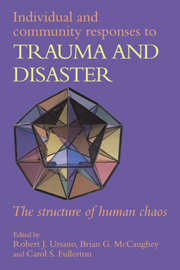Book contents
- Frontmatter
- Contents
- List of contributors
- Foreword
- Preface
- Part I Introduction
- Part II The nature of traumatic stress
- Part III The role of psychosocial context in responses to trauma and disasters
- 8 Social support and perceived control as moderators of responses to dioxin and flood exposure
- 9 Debriefing following traumatic exposure
- 10 Relocation stress following natural disasters
- 11 Group reactions to trauma: an avalanche accident
- 12 Community responses to disaster: the Gander plane crash
- Part IV Responses to trauma across the life cycle
- Part V Conclusions
- Index
8 - Social support and perceived control as moderators of responses to dioxin and flood exposure
from Part III - The role of psychosocial context in responses to trauma and disasters
Published online by Cambridge University Press: 13 October 2009
- Frontmatter
- Contents
- List of contributors
- Foreword
- Preface
- Part I Introduction
- Part II The nature of traumatic stress
- Part III The role of psychosocial context in responses to trauma and disasters
- 8 Social support and perceived control as moderators of responses to dioxin and flood exposure
- 9 Debriefing following traumatic exposure
- 10 Relocation stress following natural disasters
- 11 Group reactions to trauma: an avalanche accident
- 12 Community responses to disaster: the Gander plane crash
- Part IV Responses to trauma across the life cycle
- Part V Conclusions
- Index
Summary
This chapter discusses the impact of exposure to flooding and/or dioxin contamination on rural St. Louis residents experiencing these events in late 1982. Our study was designed to describe the type and extent of psychiatric disturbance that followed these events, and to see if victims' reactions varied for the different types of disasters. We were also interested in learning how social support and family role affected victims' reactions and which victims were most likely to experience psychological problems following exposure. Finally, we wanted to help answer the question of why some people react more negatively to both disaster exposure and the lack of social support than others do. Toward this end, we explored perceived control as a possible explanation of victims' responses to disaster.
Natural and humanmade disasters
While precise estimates are not available, it is clear that an enormous number of people in the United States are exposed to both natural and human-made hazards every year. For example, with regard to natural disasters, in its 1986 reporting year, the American Red Cross responded to 43658 disaster incidents. In that same year, the Federal Emergency Management Agency (FEMA) responded to 30 presidentially declared disasters and obligated $648 011 810 in funds for disaster relief; the National Institute of Mental Health (NIMH) also responded to nine of these disasters and distributed $1 885 654 of FEMA funds for mental health services to victims.
- Type
- Chapter
- Information
- Individual and Community Responses to Trauma and DisasterThe Structure of Human Chaos, pp. 179 - 200Publisher: Cambridge University PressPrint publication year: 1994
- 14
- Cited by

